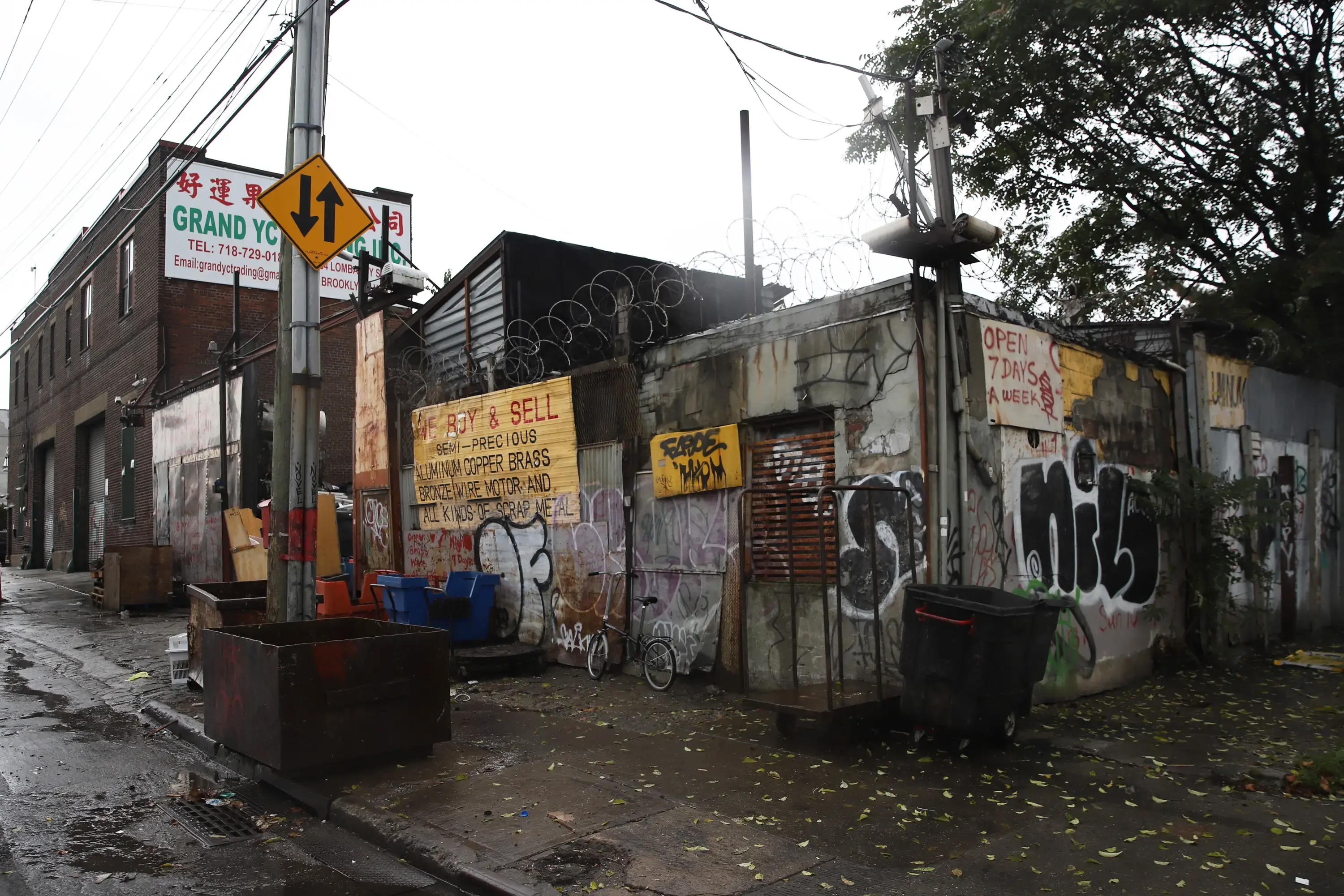
A reservoir of toxic chemicals lies below hundreds of homes in Greenpoint and East Williamsburg. The feds first need to find out if any dangerous fumes have surfaced, but that means getting property owners on board.
Hazard NYC was made possible by support from the Fund for Investigative Journalism. The project was produced in partnership with the McGraw Center for Business Journalism at the CUNY Graduate School of Journalism, and is part of the Pulitzer Center's Connected Coastlines initiative. Hazard NYC is sponsored by Brooklyn SolarWorks.

As a nonprofit journalism organization, we depend on your support to fund our nationwide Connected Coastlines climate reporting. Donate any amount today to become a Pulitzer Center Champion and receive exclusive benefits!

Christine Facella, a homeowner in East Williamsburg, Brooklyn, has created a lush urban oasis in her backyard, where she grows eggplants, tomatoes and other vegetables. She even welcomes the raccoons and stray cats that come to visit. But a threat lurks underground. Her brick row house sits on top of a federal Superfund site: the Meeker Avenue Plume.
To see maps of the area, click here.
The Environmental Protection Agency added the plume to its National Priorities List in 2022. A pool of chemicals in the groundwater and soil spans parts of Greenpoint and East Williamsburg in Brooklyn. The EPA wants to eventually clean up the area.
The main contaminants at the site are volatile organic compounds, namely tetrachloroethene (PCE) and trichloroethene (TCE), as well as cis-1,2-dichloroethylene and vinyl chloride.
The state Department of Environmental Conservation first discovered the chemical contaminants in the mid-2000s, when it was monitoring the cleanup of the Greenpoint oil spill, a leak of at least 17 million gallons.
There are thousands of homes and hundreds of businesses on top of the plume, which presents an immediate risk: “People are potentially living with the effects in their own homes,” said Lael Goodman, environmental justice program manager of the nonprofit North Brooklyn Neighbors.
The EPA is conducting its own investigation to track down the extent of the plume’s contamination. New York State had already identified six former businesses as the culprits: two dry cleaners, a soap and lacquer manufacturer, a steel drum recycler and a pair of metal foundries.

This summer, the EPA opened more than 300 wells scattered around the neighborhood to take groundwater samples to better understand the contaminants, their concentrations and locations. The investigation, which could take years to complete, builds on the state’s work.

The former steel and metal works facility, shown above, was operated by ACME Architectural Products and made metal doors and frames until about 1998. The company used a slew of solvents and chemicals, including oils, primers, degreasers and paints.
The state found groundwater contaminated with TCE on the site, which was used by a succession of businesses for metal fabrication and painting from the 1930s until about 2000.

The most immediate threat to people who live and work atop the plume is vapor intrusion. That’s when toxic fumes make their way from beneath the ground into buildings, where people breathe them in.
Even short exposures can result in watery eyes, itchy skin, nausea, dizziness or brain fog. Longer exposures can lead to a weakened immune system, damage to organs, including the liver and kidneys, or cancer.

As a result of climate change, sea levels will rise between 6 inches and over a foot by the 2030s, according to estimates by the New York City Panel on Climate Change. Water tables near the coast are also expected to rise. More intense and frequent rain, another fallout from climate change, can also raise the water table.
As the groundwater moves, it can cause the plume to change direction or rise, according to Kristina Hill, a professor of landscape architecture and environmental planning at the University of California, Berkeley. Contamination closer to the surface is more likely to be inhaled.

John Brennan, an EPA remedial project manager, said the EPA would like to test for vapor intrusion wherever high chemical concentrations are found, and sample as many houses as possible.
By testing the indoor air, the EPA can know if a property is at risk and install a system to move any toxic vapors out of the house. People who live or work in basements or on ground floors are at the greatest risk.

Over a decade ago, the state Department of Environmental Protection tested Christine Facella’s home for vapor intrusion. The state didn’t find anything, but installed a mitigation system just in case. It sends any vapors from the basement to a ventilation pipe on top of the roof.
“I've been assured that the mitigation system is enough to keep things safe, ” Facella said.

Before the EPA does its testing, the agency must get permission from property owners. That means renters need their landlords to allow the EPA inside. But some property owners (pictured above at a community information session) may be reluctant to let the government inside their buildings, whether because of general distrust or to hide illegal basement apartments.

Lael Goodman and Heidi Vanderlee, shown above, are part of a group of Greenpoint and East Williamsburg residents who have been educating neighbors about the plume and the importance of vapor testing.
“Wouldn’t you like to know if your building is safe?” Vanderlee said. “The testing, the mitigation system — none of it costs money.”

The EPA tested NYC Housing Authority's Cooper Park Houses for vapor intrusion. The agency did not find plume-related chemical contaminants at levels that would be concerning, but did find chemicals that appeared to originate from household cleaning products. Cooper Park is just south of the plume’s known boundary.
“Even though we might be outside the boundaries, we’re still part of the community,” said Debra Benders, president of the Cooper Park Resident Council.

Lisa Bloodgood, a longtime Greenpoint resident and veteran of the fight for environmental justice in the neighborhood, gardened beneath the Kosciuszko Bridge in the footprint of the plume. “One day I imagine living in a very clean community,” she said.
Written and reported by Samantha Maldonado. Design and development by Sam Rabiyah. Editing by Harry Siegel. Photos by Ben Fractenberg and Alex Krales. Additional development by Sujin Shin. Additional reporting by Jordan Gass-Pooré.
Data sources: Superfund site boundaries via the EPA. Oil spill approximation via RESGroup. Responsible parties identified by the DEC. Residential lots via NYC Planning.














